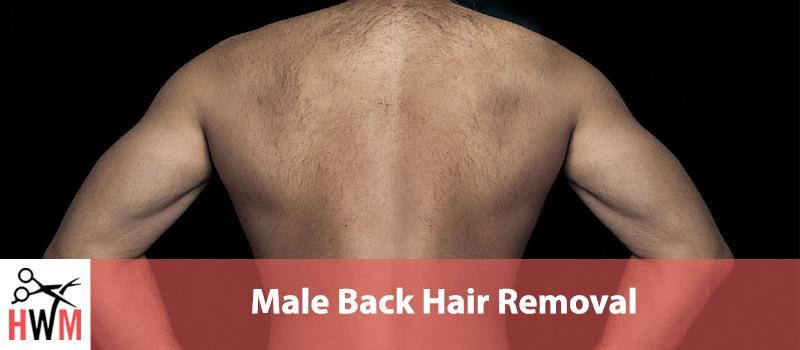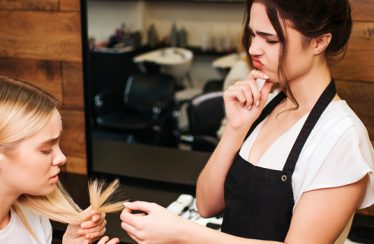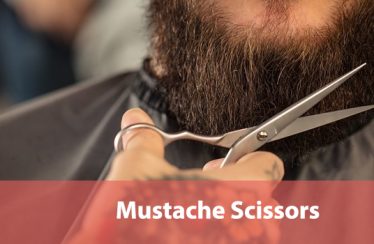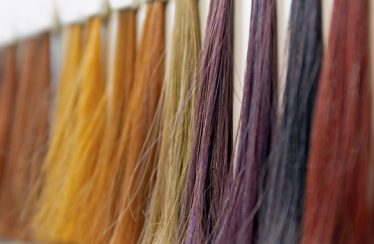It can feel like you can’t ever take your shirt off. You might be worried about taking prospective partners home for the first time, or constantly buying high-collared shirts to prevent a stray strand from showing along the back of your neck.
Back hair, while totally natural, is generally considered less attractive than other body hair. With the rise in manscaping popularity more men, even men who do not bother with removing chest, leg, facial, or arm hair, are looking into back hair removal options.
If you’re concerned about your back hair and want to remove it, it can be hard to choose between different options for hair removal. This guide will talk about the causes of back hair, why some men get it and others don’t when hair becomes a medical concern more than an aesthetic choice, and the different options for removing back hair.
We’ll also discuss the pros and cons of different hair removal methods, and how to properly care for your skin before and after hair removal to make the process as effective and painless as possible.
- Why Do Some Men Get Back Hair?
- When is Body Hair Growth Concerning?
- Different Methods for Body Hair Removal
- Skin Care After Hair Removal
Why Do Some Men Get Back Hair?
Body hair is largely a product of genetics and your body’s natural hormones. You might notice more body hair if you’re on medications that alter your hormones, are under a lot of stress, or are on the heavier side of the weight scale.
But, for the most part, the hair you have is the hair you have. Some people are naturally hairier than others, men and women both.
Back hair is usually a sign of high testosterone, which isn’t a bad thing on its own. Testosterone is involved in muscle growth, wound healing, and numerous other beneficial processes in your body.
That means that if you are concerned about your hair growth you should probably stick to mechanical means of hair removal rather than attempting to change body chemistry through medication or supplements to reduce hair growth.
By mechanical hair removal, we’re including both physical removal like shaving and epilating the hair, along with topical chemical hair removal like hair removal creams, and laser hair removal.
Before we get to the means of hair removal, let’s talk briefly about the rare forms of hair growth that can be a cause for medical concern.
When is Body Hair Growth Concerning?
The vast majority of the time body hair is not a cause for medical concern. Even excessive body hair is just natural for some men, and even some women, and doesn’t require a doctor’s intervention.
However, there are some rare forms of hair growth that deserve a trip to the doc just to be on the safe side.
You Have Hair on the Palms of Your Hands or the Soles of Your Feet
J.R.R. Tolkien’s beloved hobbits have a protective layer of skin on their hands and feet. They benefit from being able to walk around barefoot, and, presumably, aren’t as bothered by hairs in their food. But for us humans, hair growth in these areas can be a cause for concern.
Specifically, you should be worried about hair on the palms of your hands and the soles of your feet. Hair on the top of your hand (the side you can see while you’re typing) and the top of your feet isn’t worrisome even if it’s thick.
There are several reasons for this, but perhaps the most impactful is that hair in these areas is uncomfortable and can interfere with day-to-day activities.
Hair on your soles, for instance, can make socks and shoes uncomfortable. Your skin is also thickest on the bottom of your feet, so hair is more likely to be ingrown, and it’s concerning that it is trying to go through the skin at all.
On your palms, hair can interfere with grip and is difficult to keep sanitary, out of your food, and away from potentially irritating chemicals.
This form of unwanted hair growth can also be a sign of an incredibly rare hair growth condition called hypertrichosis, or werewolf syndrome.
Of course, unwanted hair growth on your palms and feet doesn’t, by itself, mean you have hypertrichosis. But it is a good reason to go to a doctor. There are other possible causes, including using a testosterone boosting cream, or simply that your hair grows that way.
Your Body Hair Starts Falling Out or Developing Noticeable Thin/Bald Patches
The condition of your hair and skin is a good indicator of your overall health. While there are situations where thin or bald patchy body hair may be normal for you, especially if it has always grown that way, developing those bald patches suddenly can be an indicator of something changing for your physical health.
The more sudden these bald and thin patches appear, the more cause for concern. A bald patch appearing over the course of several years isn’t terribly worrisome or, on its own, a reason to go to a doctor. If you start developing bald patches in a matter of weeks or months, it’s time to make an appointment.
Different Methods for Body Hair Removal

If you have decided that you want to go ahead and begin a body hair removal regimen, whether only on your back or for other portions of your body hair, there are many options available. Some do require that you have someone else helping, while others can be done easily on your own.
However, every method has some benefits and drawbacks, and no one method is the perfect solution for everyone. We’ll talk through both the pros and cons of each as we explore them.
Shaving
Shaving is probably the first method that comes to mind when you’re considering removing your back hair.
Razors are easily available, and usually cheap. There are lots of shaving cream and after-shave skin treatment options, most of which are affordable.
There are even long-handled razors, typically safety razors, that are marketed specifically for men who want to remove their back hair.
With those long-handled razors, you can shave your back on your own assuming you have moderate flexibility, some dexterity in both hands, and don’t have many moles or other skin blemishes that you need to avoid while you’re shaving.
We do recommend avoiding moles, even small ones since you’re more likely to accidentally cut the skin near those moles.
You can also ask a friend, partner, or family member to help with shaving if there are any places you can’t easily reach, are concerned about moles, or just generally would prefer someone else shave.
It’s also probably the method you’re already most familiar with. If you remove your facial hair, or ever have, you’re already familiar with all the steps you can take to make the process more comfortable and effective. Fortunately, all the same steps apply to removing back hair.
Showing before or while you shave helps relax your pores and lift the hair to make it easier to get a close shave. It can also reduce skin irritation if you’re worried about razor burn and ingrown hairs.
Shaving cream accomplishes most of the same effect and is also a good idea for shaving your back. And an after-shave moisturizing and exfoliating treatment is a great idea for your back, too.
However, shaving will only give you smooth skin for 2-3 days for most men. The angles for shaving your back can be awkward and might force you to take several more passes than you normally would. The more passes you have to take the more likely it is that your skin will be irritated by shaving.
And while it is a myth that shaving makes hair grow in thicker, it does make the hair that is there more noticeable and look thicker. The reason is that hair that has grown in naturally and existed on your skin for a longer period also has a tapered shape, whereas hair that is growing in after shaving doesn’t taper until you’ve had it for several weeks.
So, while shaving won’t make you hairier, it can make your hair appear thicker and darker than it would without shaving.
Epilating
Epilating is another option for at-home mechanical hair removal. It lasts a little longer than shaving does, can reduce the amount of hair growing in an area over time and repeated use, and leaves your skin smoother than a razor.
However, epilating, which pulls your hair out from the follicle, is uncomfortable. It can be even downright painful if you’re removing a lot of hair all at once. It only, on average, will give you an additional couple days over shaving, 4-5 days instead of 2-3.
Some people also report that epilating causes more ingrown hairs and general skin irritation than shaving does. This makes some degree of sense because part of the mechanism for reducing hair growth in an area is damaging the hair follicles, so they produce thinner weaker hair or none at all.
Like shaving, it is important to spend time moisturizing and exfoliating your skin after using the epilator. However, epilating may take slightly longer than shaving, depending on the epilator and the amount of skin.
Another drawback of epilating over shaving your back is that you almost certainly need someone else to help you. Epilating can take multiple passes, and if you don’t hold the device flush to your skin it won’t be nearly as effective.
So, epilating is a good option for men who don’t mind a little discomfort for longer-lasting results, the possibility of reducing unwanted hair growth over time and have someone they trust to help them with the hair removal process.
But it may not work well for you if you don’t have someone to help, aren’t willing to use a hair removal process that can be uncomfortable/painful, or don’t need your hair removal to last for more than a couple days.
Hair Removal Creams
Hair removal creams are almost as common as shaving cream nowadays, and they are more effective than ever.
Hair removal cream is also often the fastest means of removing unwanted hair. Depending on the formulation it may take as little as five minutes to work. You simply apply the cream, wait the required time, and then wipe the cream (and your hair) away.
You don’t have to worry about a dull razor or the discomfort of an epilator with hair removal creams. Most people do need help effectively applying hair removal cream on their backs, though, since uneven application creates uneven results.
Hair removal creams can also be irritating for sensitive skin, and the amount of time you get hair-free varies quite a bit from person to person. Expect 3-5 days, and not to be perfectly smooth the last day or two before you re-apply the cream.
This can also be a bit more expensive than shaving since you’re covering a fairly large area and will likely need to use quite a bit of the stuff every time you apply, so keeping it around and using it regularly means you’ll need to be willing to buy your preferred product pretty often.
Laser Hair Removal
Laser hair removal can be a good option if you’re looking for a permanent or semi-permanent solution to removing a lot of hair from a large area. However, the laser treatments themselves can be temporarily irritating for some people’s skin, and it’s the most expensive hair removal option.
Laser hair removal damages the hair follicles without causing damage to other parts of your skin and can provide relief from hair growth for years at a time. Some people may not ever have to have another laser treatment after completing the full successful course of it. Others will need to go back in a few years, up to a decade later, and have the treatment done again.
That long-duration of hair removal can make laser a cheaper long-term option if you can come up with the cost in the first place.
You’ll also need to plan on multiple sessions, and potentially doing the laser treatment in sections rather than treating your whole back in each session.
You can likely use other hair removal options like shaving and epilating in-between sessions, although you may want to avoid options you know irritate your skin since laser treatments can also cause temporary irritation, and you can’t do a laser treatment on skin that is too irritated or currently damaged before the treatment.
You may also notice that you still have thin fine body hair after a laser treatment. Especially thick hair will take more treatments to remove, and depending on your budget and timeframe, you may end up with thinned less-noticeable hair rather than no hair at all.
Skin Care After Hair Removal

Regardless of the hair removal method you choose, you’ll get your best possible results by caring for your skin. Unhealthy skin is not only more noticeable when it’s not covered by hair, but it can also interfere with your hair removal process.
Taking some simple steps, regardless of your chosen method, will make it easier to get and maintain a smooth back.
Moisturize
Moisturizing your skin properly is important regardless of hair removal but becomes much more impactful when you are stressing your skin with hair removal.
Unlike your face, you can get away with using normal body lotion to moisturize your back. Especially if you are shaving or epilating you should plan to use a moisturizing product immediately after.
It’s also a good idea to moisturize between hair removal sessions. Make it part of your everyday routine if you can or attempt to at least use the lotion or moisturizer once to restore your skin in preparation for your next hair removal.
If lotion isn’t your thing you can use natural oils as a moisturizer as well. Jojoba oil is a great choice since it closely mimics your skin’s natural oil, argon oil is another good option especially if your back gets a lot of sunlight since it has some natural SPF. Coconut and olive oil are other good choices, readily available at most grocery stores.
Moisturizing does more than hydrate and sooth your skin, it also helps your skin maintain a moisture barrier that prevents infection, sunburn, and windburn, along with other forms of chafing irritation.
Exfoliate
Your back is probably not the first place you think about needing to exfoliate, which can make hair removal much trickier since you’re dealing with layers of dead dry skin cells in addition to the hair.
Dry skin can also act to trap hair that is just growing in, creating ingrown hairs that at best for small back dots, and at worst can mimic bad acne and even permanently darken your skin pigment, leading to uneven skin tone.
Exfoliating a couple times a week will help eliminate all the problems that come with dry skin. Unless you have someone else helping, and doesn’t that just sound relaxing, exfoliating gloves aren’t a good option for getting to this area.
Instead, by a natural-fiber sponge back washer. These look like back scratchers but are designed to be used in the shower to make it easier to thoroughly wash your back. Using it in the shower does help to exfoliate the skin on your back, but you can also use it dry or damp between showers and after your hair removal to get even better exfoliation.
If you do have a partner who can help you exfoliate your back, you can experiment with Epsom salt or sugar scrubs that exfoliate and moisturize all at once time. Plus, it just feels good.
You shouldn’t use a traditional back scratcher to try and exfoliate since you’re either going to miss large sections of skin and not exfoliate most of your back, or you’re going to over-do it and cause damage and scratch your skin as much as you exfoliate it.
Use Warm Water and Shaving Cream
This one applies mostly if you’re either shaving or epilating.
If you’re using an epilator go ahead and skip the shaving cream, but you still want to run a warm damp washcloth over the area before you get started to help lift the hair and relax your skin. Doing this will make it easier to thoroughly remove your unwanted hair, and can help make it less painful as well.
When shaving you want to at least use a warm damp washcloth, and better to also use shaving cream. While you can dry shave other areas of skin if your skin isn’t too sensitive for that much friction, but you don’t want to do that on your back, especially if you are shaving yourself.
A big reason for this is that it’s going to take significantly longer for you to shave your back that it would to shave your face, or even your chest since you can’t see what you’re doing and need to rely on your sense of touch to guide the razor.
That’s a lot more time to irritate your skin, likely more passes, and a lot of time for the hair to settle and rest against your skin, making it more difficult to lift and cut.
Shaving cream will help prevent a lot of that irritation, provide some moisture to protect against any irritation that still happens, and will also keep your hair further from the skin and easier to effectively cut.
Conclusion
Now you’ve got the tools and information you need to make an informed decision about back hair removal or manscaping. You know what the most common hair removal options are, and how to care for your skin to keep it healthy and looking good, and when your body hair might be signaling a larger health issue that needs attention.
Remember, removing any body hair is a personal choice. If you’re comfortable with your back hair, it doesn’t cause you to overheat and doesn’t tug and pull in the weave of your shirts, and you and your partner don’t mind it being there, you don’t need to do anything about it.
But if it is uncomfortable, unwanted, or just generally unpleasant, you can make an informed decision for how you want to remove the hair immediately and in the long term.




